
Tower of Board Games
An online friend started a board gaming club at his elementary school. Occassionally, he posts pictures of the free games companies send him. Other times he posts photos of his students engaged in play. I asked him about the games and what it was like teaching children so young board games.
“We have good and bad days, but we stick to it and try different things,” he told me. “It’s all about the long-con.”
In a world of easy entertainment like movies and dazzling entertainment like video games, I’m overjoyed to see boardgames surging in popularity in America. I’m glad to see adults embracing “child’s play” as a means of cultivating mental plasticity. Games keep our minds young by challenging us and prompting us to think in unusual ways.
Plato recognized the importance of gaming in childhood when he said, “[I]f a boy is to be a good farmer or a good builder, he should play at building toy houses or at farming and be provided by his tutor with miniature tools modelled on real ones… One should see games as a means of directing children’s tastes and inclinations to the role they will fulfill as adults.” I also see immense potential for gaming in education. I’m not talking about gamified education, which involves skinner-box methods of hooking children into learning for rewards, but rather game-based learning, which means using actual game play to teach and explore concepts.
Here’s what I’ve learned from a few years of playing board games with my young boys.
Go Basic
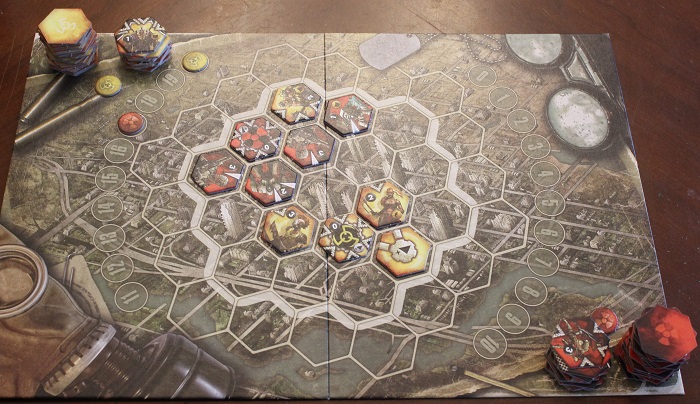
Neuroshima Hex
The single-biggest challenge to playing board games with young kids is that so many games require reading as a prerequisite. Being unable to read immediately takes trivia, spelling, sentence-building, and most mystery games out of consideration. On the other hand, math isn’t too much of a problem so long as you have plenty of patience.
An important part of the long-con is getting kids playing games with great themes even if they offer zero player agency or strategy. My four-year-old loves loves loves Candy Land because the board has such delightful artwork and he doesn’t realize that we could just as well flip a coin to determine the winner. Similarly, games like Hi Ho Cherry-O and How Does Your Garden Grow? also offer no real choices, but they do offer play sets with structure. So even though the game outcomes are just random chance, they do introduce kids to rules of play and they enjoy learning them.
A step up from zero-agency games are games that introduce a minimum of skill–if not strategy. The game Cat in the Hat combines physicality with randomness that kids enjoy. Games like Hisss, Castle Keep, Spot It!, Robot Face Race, and Set are about immediate pattern-recognition rather than planning. Dumbing down Carcassonne into a just a tile-placing game without the meeples and you have a dynamic puzzle kids can really engage. Similarly, the card game Tiny Polka Dot is another game that makes for a great pattern-matching puzzle that enlightens the child’s numeracy, where my four-year-old will spend a long time sorting the cards into columns of numbers.
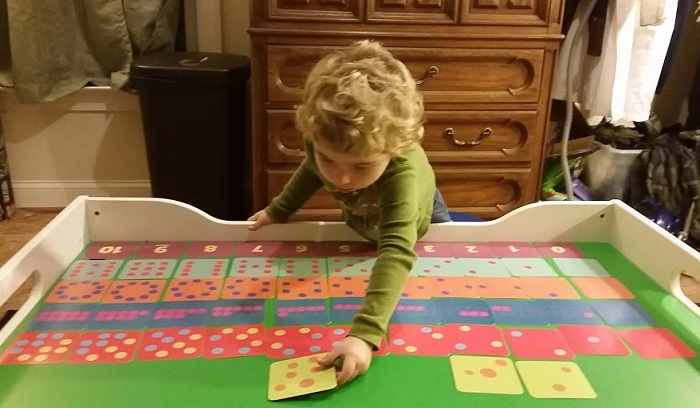
Tiny Polka Dot
Stepping from skills-based to strategic games. I’ve found my four-year-old loves the ancient game of Mancala, with its bead-dropping and easy rules. Once I built an app to teach the concept of coordinates, my boys began to thoroughly enjoy Battleship. The game Guess Who? teaches the process of elimination, but for all the variations of the game (Marvel Supeheroes, Star Wars, Disney) I wish there was a non-facial version of this game to avoid the pitfalls of guessing races and genders. I was blown away to find my kids understand the programming concepts behind Robot Turtles and Robo Rally. My six-year-old has impressed me with his understanding of the pirate-card-game Loot, the tower-defense game Castle Panic, the mathy bingo-style tile-laying Take it Easy!, and the event-stacking strategy game Neuroshima Hex. With these kinds of games, I’ve found I simply have to introduce the kids to a wide variety and see what sticks.
Go Casual

Mouse Trap
Fun fact: my boys have never finished the board game Mouse Trap. We’ve gotten as far as having 80% of the mouse trap built, and then the game devolves into seeing how far they can launch the diver or how many spins they can get on the lightpole boot. No matter how much I prompt and plead, the gaming session is doomed and I sit resigned to watch them giggle away until they are distracted onto other toys and I put everything back in the box.
And you know what? That’s perfectly fine. Young children express themselves with their bodies. They’re still developing their kinesthetic intelligence. So if they want to throw the dice high up in the air when they roll, let them. If they want to have their playing pieces talk, dance, or shoot lasers when they move, go for it. If a good dose of the sillies gets them in the game, then let there be sillies.
Don’t worry about rules. My four-year-old loves The Game of Life, but he can’t read and can’t follow the intermediate math involved. So our sessions consist of spinning the wheel, racing cars, and getting him familiar with concepts like employment, savings, and schooling. My six-year-old asks lots of tough questions about real life, and I get to appreciate and deconstruct the politics and cultural norms the gameboard promotes. We’re together, we’re engaged with one another, and we are all learning something from the exercise.
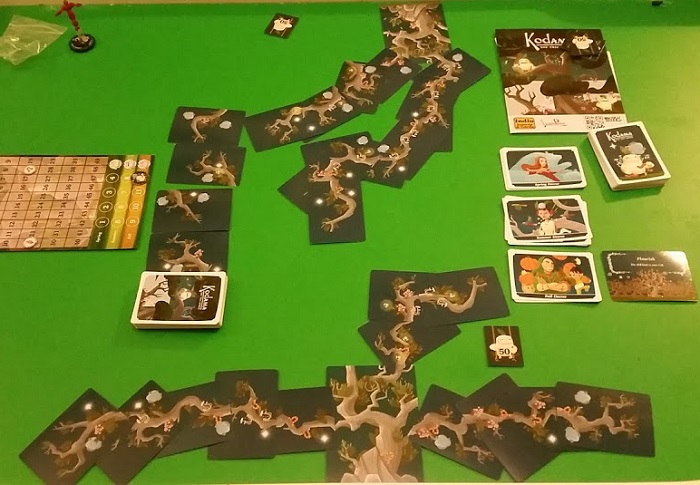
Kodama
Also look for opportunities to make games easier for kids. Bring things down to their level. For example, my boys have a hard time remembering where all the invisible walls are in The Magic Labyrinth, so when they hit a wall, I add a marker so they know where it is on future turns. My boys hate the helpless randomness of Chutes and Ladders, so I replaced the spinner with a selection of dice from which to choose their chances. My six-year-old can play Magic, The Gathering when we construct creatures-only decks with mana and ignore the abilities texts. We can play Kodama when we eliminate the tree spirits that add so much personal strategy to the game. We even play most of our competitive games cooperatively, with the winner contributing their spins and rolls to help the other players catch up and cross the finish line–because because we don’t play zero-sum games in the real world.
Go Cooperative
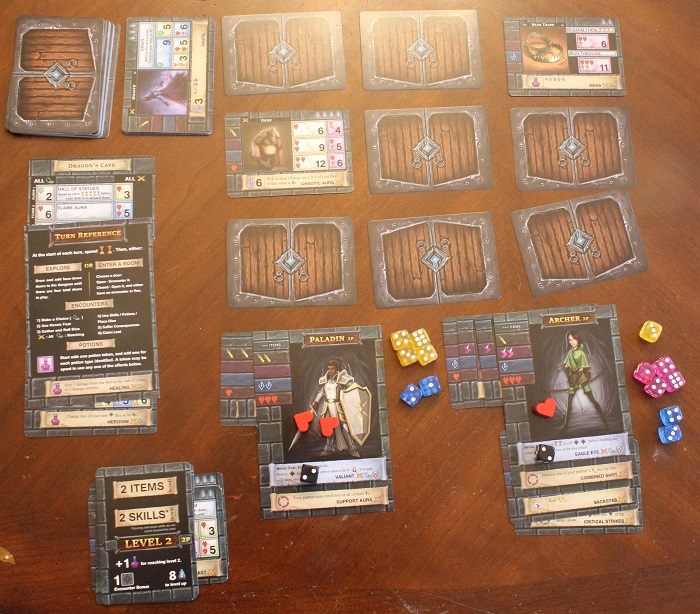
One Deck Dungeon
This is a big one with my boys. I think kids are naturally comparing themselves to everyone else and are being subject to comparisons by everyone else. Plus, playing board games against your parents, the people who are your mentors, is intimidating. Board games are about play and modeling the real world. In the real world, we work cooperatively with those around us.
That’s why cooperative board games are such a wonderful innovation. Simple fun games like Dinosaur Escape, Mole Rats in Space, Powerpuff Girls, or Monster Chase generate this infectious joy as everyone tries to save the dinosaurs, mole rats, or ourselves from the monsters. The Eye Found It games in Busytown, Disney, and Time Travel flavors offer a joint adventure of exploration. While games like Forbidden Island and Forbidden Desert offer team-play for kids based on the gameplay of Pandemic that I think will help kids step up to those more advanced games.
Most of all, cooperative also opens up opportunities for much more advanced game play. It’s easy to say our opponents are our teachers, but in practice it’s not so easy. Kids are much more relaxed with their parents as allies instead of adversaries and can better appreciate the mentorship of a more advanced player who happens to be on their side. Because of this, I’ve been able to play highly-strategic games like Castle Panic and Star Trek Panic tower-defense games. I’ve also been able to dungeon-crawl with the intermediate mathematics of One Deck Dungeon. Because these games are more on my level of play, I get much more personal enjoyment out of our gaming sessions as well.
Go Second-Hand and DIY
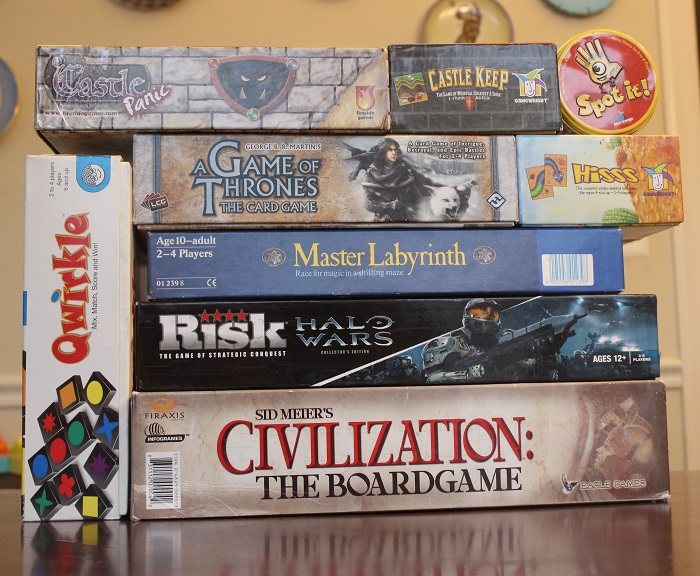
Thrift Store Finds
Pro-tip: Thrift stores are an amazing way to kick off a board game library. I was wary at first. Wouldn’t I just be buying junk when I get home to open the box and find it missing parts?
In practise, yes, several purchases have been missing some pieces, but playing a game with a card or two missing from the deck or having to find makeshift playing pieces turns out to be perfectly fine. Hey, if an old shoe can represent a player in Monopoly, what does it matter if you use a quarter for Colonel Mustard in Clue?
That said, my board game thrifting experiences has been overwhelming positive. I’ve made some fantastic finds for epic board games like Halo Wars Risk and Sid Meier’s Civilization: The Boardgame that can serve as a playset for younger kids despite having rules that are way-too-advanced for them. I don’t mind if the boys open the box and spread the bazillion pieces about because I got these games for three dollars each.
Thrift stores also introduce me to so many games that were never on my radar. Reading the gaming sites, I’m always expanding my wishlist of $50 games based on what’s the most popular to come out at the moment. In the thrift stores I can experiment and grab whatever sounds interesting, making discoveries like the shifting maze game Master Labrynth, the tetris-like Blokus, and the pattern-matching Qwirkle.

Isometric Graph with Pattern Blocks
There’s also the option to go DIY with many board games. For example, Mancala can be played with some beads, two bowls, and an empty egg carton. I produced a nice-quality game board with a square of plywood, a pen, and some geometry. On one side I made a Go Board with with one-inch squares, which fit Jenga blocks so that we could make mazes and dungeons. On the other side of the board, I drew an Isometric Grid that fit our barrel of Pattern blocks (see my javascript simulation of this here). On the higher end, Lego blocks and Heroscape tiles offer lots of opportunities for worldplay.

Go Board with Jenga Blocks
Another DIY avenue is Print-and-Play games. These are free PDFs and images you can print out for yourself. Every year, BoardGameGeek.com hosts a Children’s Game Print and Play Design Contest (see 2015, 2016, 2017). Through these contests, I’ve found some great kids and solitare games like the bead-dropping Raindrops, math adventure Boss Gauntlet, 8-Bit Invaders math game, the path-making Arcade Road Maker, and the gallery nature-hike game Bear Went Over the Mountain. DIY and second-hand offer low-cost ways to experiment with all kinds of themes and mechanics to see what works for your family.
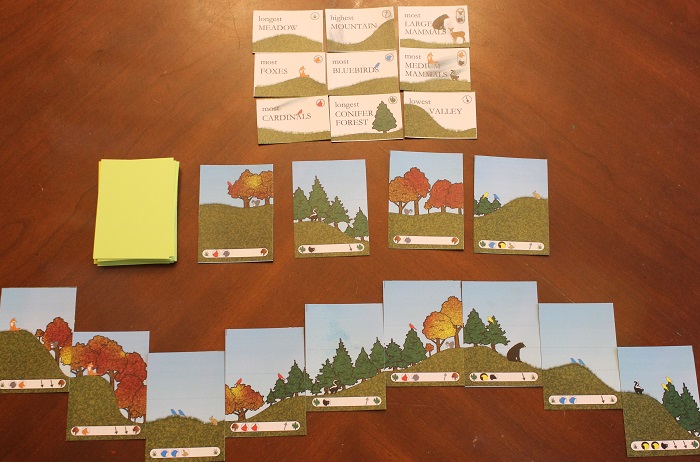
Bear Went Over the Mountain
Go Persistent
My parenting stress-levels dropped significantly when I came to understand just how much all kids are different. Some kids can read before they get into kindergarden. Some are much more familiar with mathematics than others. Some have better verbal skills. It’s not the end of the world if a child is behind in something at this early stage, and it’s not worth stressing them out over it. Like my boys’ grandma used to say, “They won’t be sucking their thumbs when they get to college.” You have time, but be mindful.
What does matter is gentle, persistent focus on these skills–not the child’s focus, but the parent’s. And this is true of gaming. Don’t feel bad if I described games my kids can play but yours can’t. Don’t try and force those specific games on your kids as a means of getting them to catch up. There are lots of games my kids can’t play, I just didn’t cover them.
Instead, try lot’s of games. Find the ones that work; occassionally revist the ones that didn’t. Try variations on the themes that worked. Explore new mechanics as new ways of thinking. And if the kids want to throw the dice in the air and play with the tokens like action figures, enjoy that time with them. More than anything, board games are one-on-one personal time with your kids, and that’s more valuable than the specific mechanics or theme of the games you play.
You can check out my board game collection at boardgamegeek.com.